What is Cottage Cheese? An Exciting Guide to Its Many Uses

Did you know that the humble cottage cheese you see on your grocery store shelves is actually a powerhouse of versatility? Often relegated to the sidelines as a dull diet food, cottage cheese has been quietly filling the role of culinary chameleon for years.
It’s high time we shine a spotlight on this unassuming dairy product and explore its myriad uses that extend far beyond the salad bowl.
Whether you’re a seasoned cook looking to experiment with new ingredients or you’re simply trying to incorporate more protein into your meals, this guide will help you discover just how exciting cottage cheese can be.
Quick Facts About Cottage Cheese
| Quick Facts | Detailed Description |
|---|---|
| Origin | Cottage cheese originated in Europe and was brought to America by early settlers. It’s named after the ‘cottages’ where it was typically made. |
| Production | Made from cow’s milk, the process of making cottage cheese involves curdling milk, draining the whey, and washing the remaining curds. |
| Nutrition | High in protein and low in fat, cottage cheese is a popular choice for those seeking a healthy dairy option. It also contains essential nutrients like calcium, vitamin B12, and phosphorus. |
| Varieties | There are several varieties of cottage cheese, including full-fat, reduced-fat, and non-fat versions. Some are small-curd while others are large-curd, depending on the type of culture used. |
| Uses | Cottage cheese can be enjoyed on its own or added to a variety of dishes, such as salads, dips, pancakes, and desserts. It’s also a popular post-workout snack due to its high protein content. |
| Storage | Cottage cheese should be refrigerated and consumed within 10 days of opening. Unused portions can be frozen for up to 6 months. |
| Health Benefits | Regular consumption of cottage cheese can contribute to bone health (due to its high calcium content), muscle building and recovery (due to its high protein content), and gut health (due to the presence of probiotics in some varieties). |
What is Cottage Cheese?
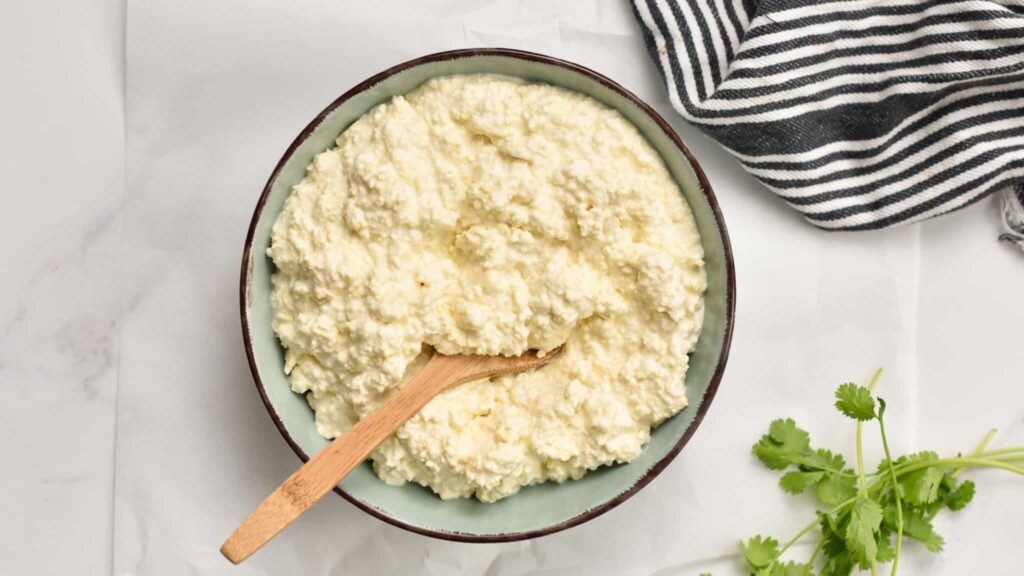
Cottage cheese is a type of fresh cheese, meaning it’s not aged before consumption. It is known for its mild flavor and distinctive curdled texture.
The cheese is made by adding an acid (like lemon juice or vinegar) or bacteria to pasteurized cow’s milk, which causes the milk to curdle. The curdled milk is then drained, leaving behind lumpy clusters known as curds. These curds make up the chunky part of cottage cheese. The remaining liquid, called whey, can be left in the cheese to create a creamier product, or further drained for a drier, curdier cheese.
Cottage cheese comes in several varieties, including small-curd, large-curd, low-fat, and full-fat versions. It can be eaten on its own, used as a spread on toast, or incorporated into various recipes such as salads, dips, desserts, and more.
Nutritionally, cottage cheese is high in protein and contains essential nutrients like calcium, phosphorus, and vitamin B12. It’s often popular among athletes and those on high-protein diets due to its high protein content and low-fat levels.
What does Cottage Cheese taste like
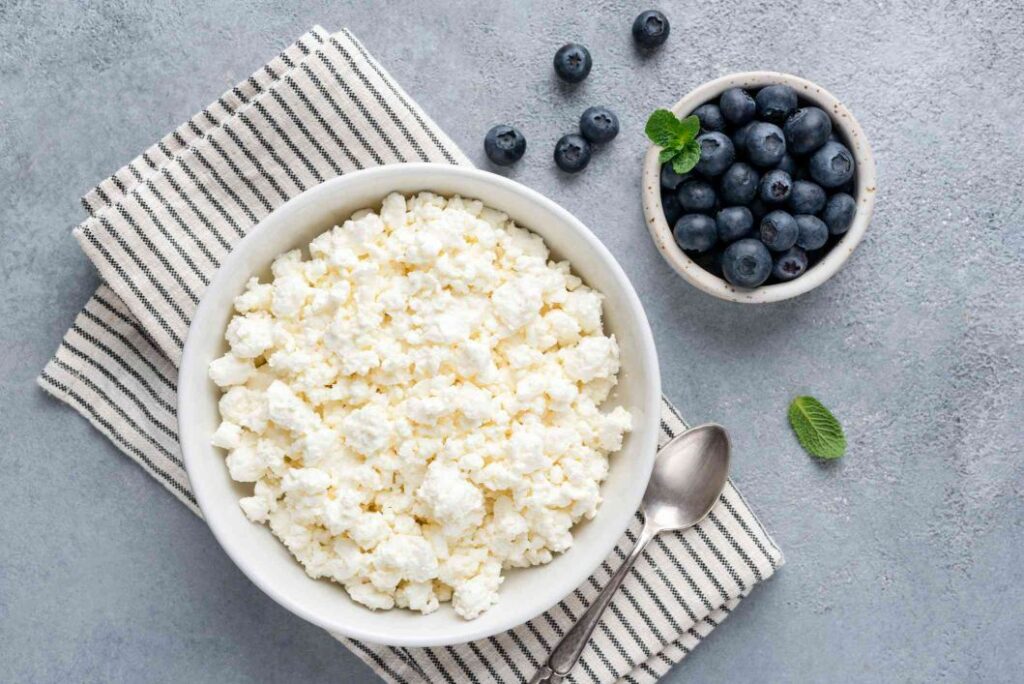
Cottage cheese has a mild, creamy, and slightly tangy flavor. The taste can be described as milky and fresh, with a hint of acidity from the fermentation process. The curds have a soft, moist, and somewhat granular texture that is unique to cottage cheese.
The flavor of cottage cheese can vary depending on the fat content and any additional ingredients. Full-fat cottage cheese tends to be creamier and richer, while low-fat or non-fat versions may be slightly more tangy and less creamy. Some varieties of cottage cheese are also flavored with added fruits, herbs, or spices, which can alter the taste.
Overall, the gentle taste of cottage cheese makes it versatile in both savory and sweet dishes, from salads and dips to pancakes and desserts.
Detailed tasting notes for Cottage Cheese
- Texture: Cottage cheese has a distinctive, chunky texture from the curds. The curds themselves are soft, moist, and slightly granular. The creaminess can vary based on the fat content; full-fat versions are often silkier and richer, while low-fat or non-fat types may be a bit drier.
- Flavor: The flavor of cottage cheese is mild, fresh, and slightly tangy. There’s a subtle sweetness that comes from the milk, balanced by a light acidity from the fermentation process.
- Aftertaste: The aftertaste is clean and refreshing, with a lingering creaminess. The tanginess can become more pronounced in the aftertaste, especially in lower-fat varieties.
- Aroma: Cottage cheese has a very light aroma that is slightly milky and sour. It doesn’t have the strong, pungent smell that many aged cheeses have.
- Visual: Visually, cottage cheese is white with visible curds. The size of the curds can vary; some are small while others are large. The cheese is moist, and sometimes there is visible whey or cream depending on how much it has been drained.
- Mouthfeel: In the mouth, cottage cheese is creamy and moist, but the curds provide a slight granularity. The cheese is easy to chew and swallow.
Is Cottage Cheese healthy?
Yes, cottage cheese is healthy due to its nutritional profile.
- High in Protein: Cottage cheese is a great source of protein, which is essential for repairing body tissues, supporting immune function, and promoting satiety or the feeling of fullness. This makes it a popular choice among athletes and those on high-protein diets.
- Low in Fat and Calories: Lower-fat versions of cottage cheese can be a good choice for those looking to manage their weight or reduce calorie intake.
- Rich in Nutrients: Cottage cheese contains a variety of essential nutrients, including calcium (important for bone health), phosphorus (works with calcium to build bones), and vitamin B12 (necessary for nerve function and the production of red blood cells).
- Digestive Health: Some types of cottage cheese contain probiotics or beneficial bacteria that support gut health.
- Blood Sugar Control: The high protein content in cottage cheese can help control blood sugar levels, making it a good option for people with diabetes.
Note: cottage cheese should be eaten in moderation as part of a balanced diet. Some versions can be high in sodium, so those watching their sodium intake should opt for low-sodium varieties when possible.
Also read: Why Cottage Cheese Is Super Healthy and Nutritious – Healthline
Cottage Cheese nutrition facts
| Nutrition Fact | Value (per 100g serving) |
|---|---|
| Calories | 81 – 98 |
| Protein | 11g – 14g |
| Carbohydrates | 3g – 5g |
| Total Fat | 1g – 6g |
| Saturated Fat | 1.4g – 3.5g |
| Sodium | 20mg – 321mg |
| Fiber | 0g |
| Sugars | 4.1g |
| Vitamin B12 | 29% of the Daily Value (DV) |
| Calcium | 125 milligrams (10% DV) |
| Selenium | 30% of the Daily Value (DV) |
| Riboflavin | 20% of the Daily Value (DV) |
Which Cottage Cheese is the Healthiest and has the Best Culture
Here’s a quick comparison of the nutritional value of different cottage cheese brands:
| Brand | Protein per 100g | Fat per 100g | Sugar per 100g | Additives |
|---|---|---|---|---|
| Good Culture | 19g | 2.5g | 3g | No |
| Daisy | 11.6g | 4.8g | 3g | No |
| Nancy’s | 14g | 2.5g | 2g | No |
| Organic Valley | 13g | 2.5g | 3g | No |
| Kalona SuperNatural | 14g | 4.5g | 3g | No |
| Muuna | 15g | 2.5g | 4g | No |
| Breakstone’s | 12g | 5g | 4g | Yes |
All of these brands are good sources of protein, and most have low sugar and fat content.
Good Culture comes out on top in terms of protein content, and Nancy’s has the lowest sugar content.
Brands like Good Culture, Daisy, Nancy’s, Organic Valley, Kalona SuperNatural, and Muuna don’t use additives in their products, which can be a plus for those looking to avoid unnecessary ingredients.
In terms of the culture used in the cheese-making process, Good Culture stands out as they use a probiotic culture that contributes to gut health.
Why I Recommend Good Culture Cottage Cheese
This section is written by: Hillary Wong, a certified nutritionist (Renal Dietitian at Fresenius Medical Care)
As a nutritionist, I would highly recommend Good Culture’s cottage cheese for a number of reasons.

Buy on Amazon
Price: $5.99
Firstly, its protein content is impressive, with 19g of protein per 100g serving. This is higher than many other brands on the market, making it a great choice for those who are looking to increase their protein intake. Protein is an essential nutrient that helps in repairing body cells, building and repairing muscles, and it’s also involved in the creation of enzymes and hormones.
Secondly, Good Culture’s cottage cheese contains only 2.5g of fat and 3g of sugar per 100g serving, making it a lower-fat and lower-sugar option compared to many other brands. This makes it a healthier choice for those who are mindful of their fat and sugar intake.
What sets Good Culture apart from other brands is the fact that they use a probiotic culture in their cheese-making process. Probiotics are live bacteria and yeasts that are good for your health, especially your digestive system. We usually think of bacteria as something harmful, but our body is full of bacteria, both good and bad. Probiotics are often called “good” or “friendly” bacteria because they help keep our gut healthy.
Moreover, Good Culture does not use any additives in their products. This means you’re getting a cleaner product without unnecessary ingredients. For those who are conscious about what goes into their food, this can be a significant advantage.
Finally, not only is Good Culture’s cottage cheese nutritionally beneficial, but it also tastes great. It has a rich, creamy texture and a fresh, slightly tangy flavor that works well in both sweet and savory dishes. Whether you enjoy it on its own, with fruit, or in a salad, it’s a versatile addition to your diet.
In conclusion, based on its high protein content, low fat and sugar levels, the use of probiotic culture, absence of additives, and great taste, I would highly recommend Good Culture’s cottage cheese as a healthy and delicious choice.
What to Eat with Cottage Cheese? The Best Pairing
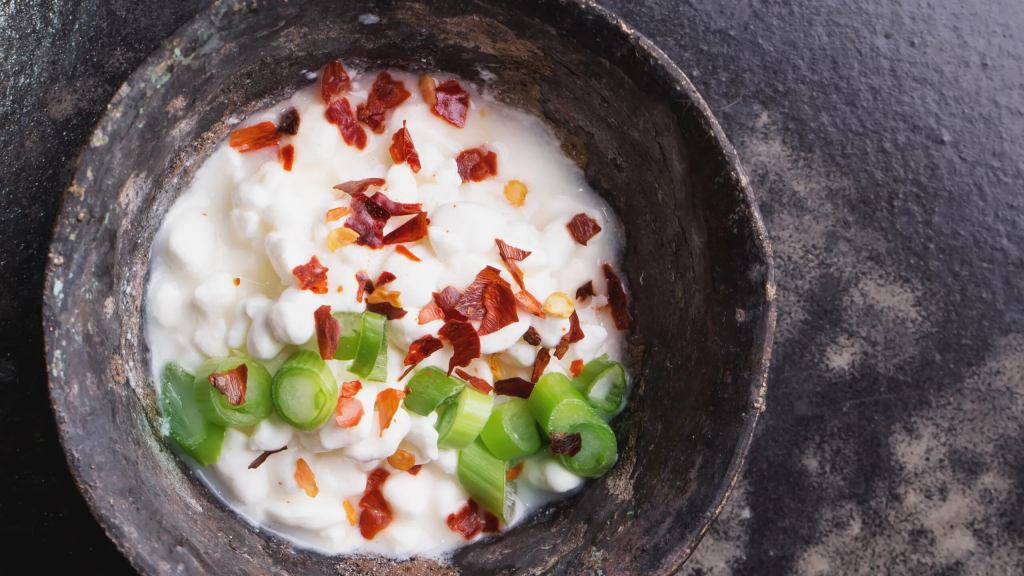
Food that goes well with Cottage Cheese:
| Category | Foods |
|---|---|
| Fruits | Pineapple, Berries, Peaches, Bananas |
| Vegetables | Tomatoes, Cucumbers, Avocado, Bell peppers, Spring Onions |
| Grains/Cereals | Whole grain toast, Oatmeal, Granola |
| Sweeteners | Honey, Maple syrup, Agave nectar |
| Nuts/Seeds | Almonds, Walnuts, Chia seeds, Flax seeds |
| Meats | Smoked salmon, Grilled chicken |
| Herbs/Spices | Dill, Chives, Black pepper, Paprika |
| Others | Greek yogurt, Dark chocolate |
Also read: What Fruit Goes on a Charcuterie Board?
Beverage that goes well with Cottage Cheese:
| Category | Beverages |
|---|---|
| Tea | Green tea, Herbal tea, Black tea |
| Coffee | Americano, Latte, Iced coffee |
| Juice | Orange juice, Apple juice, Grapefruit juice |
| Smoothies | Berry smoothie, Green smoothie, Banana smoothie |
| Milk | Almond milk, Cow’s milk, Soy milk |
| Others | Water, Sparkling water, Protein shake |
Also read: A Comprehensive Guide to Enjoying Cheese Platter with Wine
A Step-by-step Guide on How to Make Cottage Cheese at Home
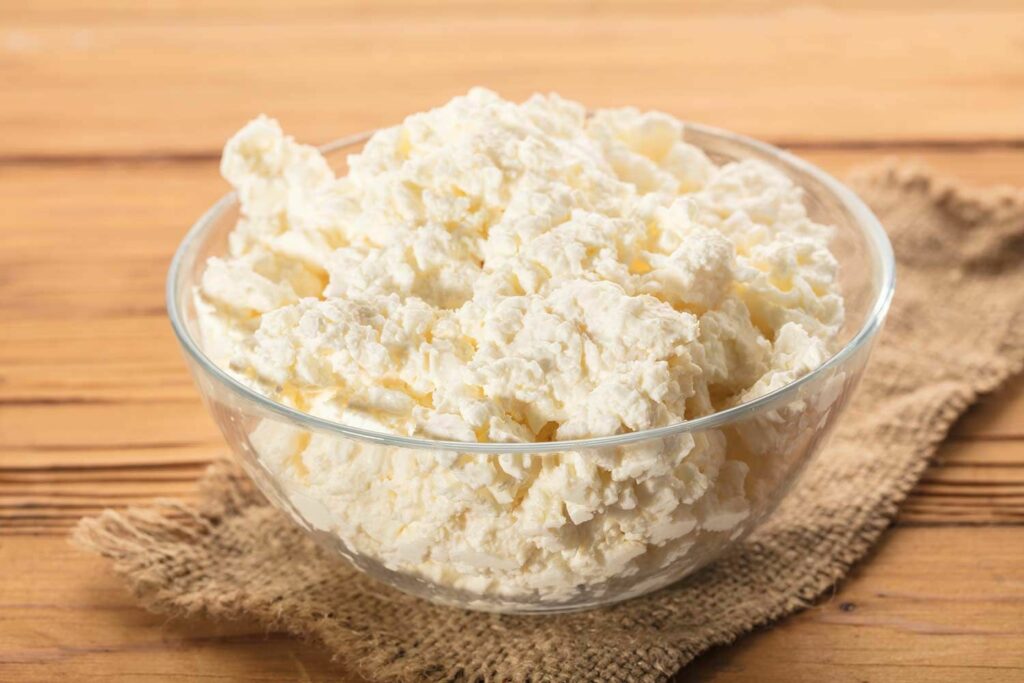
Ingredients:
- 1 Gallon of Whole Milk (Preferably organic and not ultra-pasteurized)
- 3/4 cup of White Vinegar
- 1 teaspoon Salt (or to taste)
Equipment:
- Large Stainless Steel Pot
- Long Knife (for cutting curds)
- Slotted Spoon
- Thermometer
- Colander
- Cheesecloth
- Bowl (to catch the whey)
- Storage Container
Step-by-step Instructions:
- Pour the milk into the large pot. Heat it over medium heat until it reaches a temperature of about 120 degrees Fahrenheit. Stir occasionally to prevent the milk from scorching at the bottom of the pot.
- Once the milk has reached the correct temperature, remove the pot from the heat. Pour in the vinegar and stir gently to combine. The milk should start to curdle almost immediately.
- Cover the pot with a lid and let it sit undisturbed at room temperature for about 2 hours. This allows the curds to fully separate from the whey.
- After 2 hours, the curds should look like lumpy custard, while the whey will appear as a clear yellowish liquid. If the milk hasn’t finished separating, let it sit for another hour.
- Line a colander with a double layer of cheesecloth. Place the colander over a large bowl to catch the whey. With a slotted spoon, gently ladle the curds into the colander.
- Once all of the curds are in the colander, sprinkle them with the salt and gently stir to combine. The salt not only adds flavor but also helps to draw more moisture out of the curds.
- Gather the corners of the cheesecloth and tie them together to form a pouch. Hang this pouch over a bowl or the sink and let it drain for about 3 hours.
- After draining, remove the cheese from the cheesecloth. Your cottage cheese is now ready to eat! It can be stored in a covered container in the refrigerator for up to 1 week.
Tips and Tricks:
- For creamier cottage cheese, add a little heavy cream or milk after the cottage cheese has drained.
- The consistency of your cottage cheese depends on how long you let the curds drain. For drier cottage cheese, let it drain for an additional hour or two.
- Save the whey! It’s full of protein and can be used in place of buttermilk or water in many recipes, including bread, pancakes, and smoothies.
- Feel free to experiment with different flavorings. Try adding a bit of honey, cinnamon, or fresh herbs to your cottage cheese for a tasty twist.
Why is Cottage Cheese Better than Yogurt?
Cottage cheese can be considered better than yogurt for these 4 reasons:
| Comparison Point | Cottage Cheese | Yogurt |
|---|---|---|
| Protein Content | High – A one-cup serving of cottage cheese can contain around 28 grams of protein. | Lower – A one-cup serving of Greek yogurt typically contains about 20 grams of protein. Regular yogurt has even less. |
| Sugar Content | Lower – Cottage cheese generally has less sugar than yogurt, especially flavored varieties of yogurt. | Higher – Even plain yogurt usually has some natural sugars, and flavored varieties can have quite a bit more. |
| Versatility in Meals | High – Due to its mild flavor, it can be used in both sweet and savory dishes. | Moderate – While yogurt is commonly used in a variety of dishes, its tangy flavor could limit its use in certain recipes. |
| Digestibility | Easier – Some people find cottage cheese easier to digest compared to yogurt. | Can be harder – Some people might find yogurt harder to digest, especially those sensitive to lactose. However, the probiotics in yogurt can help improve gut health. |
The truth is, that whether cottage cheese is ‘better’ than yogurt can depend on individual dietary needs and preferences. Both are nutrient-rich dairy products that can be part of a balanced diet. It’s also important to note that the nutritional content can vary based on the specific product brand and type.
Top 10 Cottage Cheese Substitutes
| Substitute | Description |
|---|---|
| Greek Yogurt | Greek yogurt has a similar texture to cottage cheese and is high in protein. It can be used in both sweet and savory dishes. |
| Ricotta Cheese | Ricotta has a similar consistency to cottage cheese but is slightly sweeter. It’s great for desserts and Italian dishes. |
| Sour Cream | Sour cream can provide a similar tanginess as cottage cheese, but it has a higher fat content. It’s good for dips and dressings. |
| Tofu | Tofu is a great vegan substitute. It can be crumbled to mimic the texture of cottage cheese and is high in protein. |
| Egg Whites | Egg whites are a protein-rich substitute. They can be scrambled to mimic the texture of cottage cheese. |
| Fromage Blanc | This is a French fresh cheese that is similar to cottage cheese. It’s creamy and slightly tart. |
| Quark | Quark is a type of fresh dairy product. It’s creamy and soft and can be used in both sweet and savory dishes. |
| Kefir | Kefir is a fermented milk product that has a similar tangy flavor to cottage cheese. It’s more liquid, so it works well in smoothies. |
| Goat Cheese | Goat cheese has a stronger flavor than cottage cheese, but it can be used in many of the same dishes. |
| Mascarpone | Mascarpone is a creamy Italian cheese that can substitute for cottage cheese in desserts and sweet dishes. |
The History and Origin of Cottage Cheese: A Humble Dairy Icon
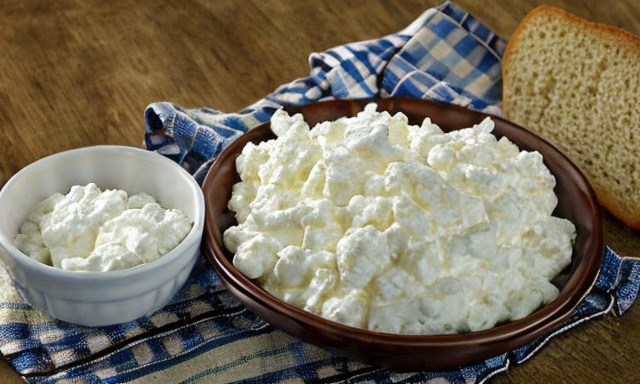
Cottage cheese, a staple in many households, is a fresh cheese curd product with a mild flavor. It’s known for its lumpy texture, which comes from the curds of cow’s milk, and is often enjoyed in salads, as a topping, or on its own. This simple dairy product holds a significant place in modern cuisine due to its versatility and nutritional value.
The earliest known instances of cottage cheese date back to prehistoric times. While the exact origin remains uncertain, it’s believed that cheese was discovered accidentally by storing milk in containers made from animal stomachs. According to Homer’s Odyssey, the Cyclops Polyphemus made cheese by storing milk, leading to the formation of cheese curds – a process not dissimilar to how cottage cheese is made today.
The term ‘cottage cheese’ is believed to have originated in the early 19th century. As the name suggests, this cheese was usually produced in cottages from leftover milk after making butter. The simplicity of the production process made it a popular choice for households, contributing significantly to its widespread use.
Cottage cheese production involves the addition of an acid (like vinegar or lemon juice) or bacteria to warm milk, causing it to curdle. The resulting curds are then drained but not pressed, allowing some whey to remain. Over time, this process has seen few changes, though commercial manufacturers might add cream or salt for flavor.
Regional variations of cottage cheese exist worldwide. In Europe, it’s commonly used in traditional dishes. For instance, Eastern European countries use a variant called ‘tvarog’, while in Britain, it’s often enjoyed with pineapple. In the United States, cottage cheese gained popularity in the mid-20th century as a health food due to its high protein and low-fat content.
Nutritionally, cottage cheese offers a host of benefits. It’s rich in protein, calcium, and vitamins, making it a favorite among health enthusiasts and those following weight loss diets. Its high protein content also makes it popular among athletes and those looking to build muscle mass.
Despite its humble origins, cottage cheese has been subject to myths and folklore. One popular myth is that eating cottage cheese before bed can help with weight loss due to its slow-digesting casein protein. While it’s true that cottage cheese contains casein, the overall impact on weight loss will depend on total calorie intake and expenditure.
In conclusion, cottage cheese, with its rich history and nutritional value, continues to hold a beloved place in global cuisine. From humble home kitchens to the spotlight of health and fitness, this versatile dairy product has come a long way and continues to be enjoyed by many.
Also read:
- The Ultimate Guide to Queso Blanco: A Taste of Mexico
- All About Roquefort: An Insider’s Guide to the King of Blue Cheese
- Asiago Cheese: An In-depth Exploration of Nutrition and Taste
- The Ultimate Guide to Jarlsberg: Delicious and Nutritious
- Ricotta Guide: All You Need to Know About This Versatile Cheese
- Neufchâtel: A Creamy Delight from Normandy
- The Ultimate Guide to Paneer Cheese: India’s Favorite Cheese





